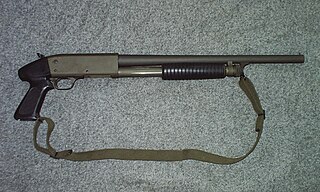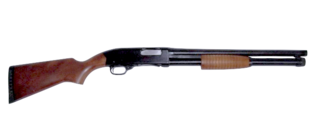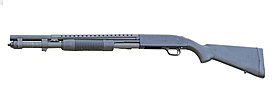
A shotgun is a long-barreled firearm designed to shoot a straight-walled cartridge known as a shotshell, which usually discharges numerous small pellet-like spherical sub-projectiles called shot, or sometimes a single solid projectile called a slug. Shotguns are most commonly smoothbore firearms, meaning that their gun barrels have no rifling on the inner wall, but rifled barrels for shooting slugs are also available.
The Winchester Model 1897, also known as the Model 97, M97, or Trench Gun, is a pump-action shotgun with an external hammer and tube magazine manufactured by the Winchester Repeating Arms Company. The Model 1897 was an evolution of the Winchester Model 1893 designed by John Browning. From 1897 until 1957, over one million of these shotguns were produced. The Model 1897 was offered in numerous barrel lengths and grades, chambered in 12 and 16 gauge, and as a solid frame or takedown. The 16-gauge guns had a standard barrel length of 28 inches, while 12-gauge guns were furnished with 30-inch length barrels. Special length barrels could be ordered in lengths as short as 20 inches, and as long as 36 inches. Since the time the Model 1897 was first manufactured it has been used by American soldiers, police officers, and hunters.

The Mossberg 500 (M500) is a series of pump action shotguns manufactured by O.F. Mossberg & Sons. The 500 series comprises widely varying models of hammerless repeaters, all of which share the same basic receiver and action, but differ in bore size, barrel length, choke options, magazine capacity, stock and forearm materials. Model numbers included in the 500 series are the 500, 505, 510, 535, and 590. The Revelation 310 and the New Haven 600 were also variations of the 500 series produced by Mossberg under different names. By 2021, 11,000,000 M500s had been produced, making it the most-produced shotgun of all time.

The Smith & Wesson Model 29 is a six-shot, double-action revolver chambered for the .44 Magnum cartridge and manufactured by the United States company Smith & Wesson.
A combat shotgun is a shotgun issued by militaries for warfare. The earliest shotguns specifically designed for combat were the trench guns or trench shotguns issued in World War I. While limited in range, the multiple projectiles typically used in a shotgun shell provide increased hit probability unmatched by other small arms.

The .410 bore is one of the smallest caliber of shotgun shell commonly available. A .410 bore shotgun loaded with shot shells is well suited for small game hunting and pest control. The .410 started off in the United Kingdom as a garden gun along with the .360 and the No. 3 bore rimfire, No. 2 bore rimfire, and No. 1 bore rimfire. .410 shells have similar base dimensions to the .45 Colt cartridge, allowing many single-shot firearms, as well as derringers and revolvers chambered in that caliber, to fire .410 shot shells without any modifications.

A riot shotgun is a shotgun designed or modified for use as a primarily defensive weapon, by the use of a short barrel and sometimes a larger magazine capacity than shotguns marketed for hunting. The riot shotgun is used by military personnel for guard duty and was at one time used for riot control, and is commonly used as a door breaching and patrol weapon by law enforcement personnel, as well as a home defense weapon by civilians. Guns of this type are often labeled as breaching shotguns, tactical shotguns or special-purpose shotguns to denote the larger scope of their use; however, these are largely marketing terms.
The Remington Model 7600 is a series of pump-action centerfire rifles made by Remington Arms. The Model 7600 is a progression from the original Model 760 pump-action rifle which Remington produced from 1952 to 1981. Production of the Model Six began in 1981 and was discontinued in 1987. Production of the Sportsman model 76 began in 1985 and was discontinued in 1987. Production of the model 7600 began in 1987 to present.
The Remington Model 11-87 is a semi-automatic shotgun manufactured by Remington Arms and based on the earlier Model 1100. The Model 11-87 remains in contemporary production, 36 years after being introduced in 1987.

The Ithaca 37 is a pump-action shotgun made in large numbers for the civilian, law enforcement and military markets. Based on a 1915 patent by firearms designer John Browning for a shotgun initially marketed as the Remington Model 17, it utilizes a novel combination ejection/loading port on the bottom of the gun which leaves the sides closed to the elements.
The Remington 1100 is a gas-operated semi-automatic shotgun introduced by Remington Arms in 1963.
The Maverick 88 is a pump action shotgun manufactured for O.F. Mossberg & Sons. The Maverick 88 is virtually identical to the Mossberg 500. Factory Maverick 88s feature a black, synthetic only stock and forearm, cylinder bore, and cross-bolt safety. Most accessories not dealing with the trigger are interchangeable with a Mossberg 500.
The Norinco HP9-1, also known as the Norinco N870-14.00 and Norinco M982, is a short pump action shotgun made by weapons manufacturer Norinco.

The Model 1200 is a pump-action shotgun that was manufactured by the Winchester-Western Division of Olin Corporation, starting 1964. It was redesignated the Model 1300 in 1978 with minimal changes. Production ceased in 2006 when the U.S. Repeating Arms Company, the subsequent manufacturer, went bankrupt. A militarized version of the Model 1200 was acquired by the U.S. Army for use during the Vietnam War. It has seen service with the U.S. military in various conflicts through into the twenty-first century.
The Winchester Model 1911 SL Shotgun was a self-loading, recoil-operated shotgun produced by the Winchester Repeating Arms Company from 1911 to 1925. It was Winchester's first autoloading shotgun, but design flaws kept it from providing competition for the autoloading shotguns made by Remington Arms and Browning Arms Company.

The Remington Model 7400 is a series of semi-automatic rifles manufactured by Remington Arms. The Model 7400 was a replacement of the Model 740 rifle which Remington produced from 1952 to 1981. The 7400 model was ultimately replaced by the Model 750 in 2006.
The Remington Model 887 Nitro Mag is a pump-action shotgun manufactured by Remington Arms Company, Inc. It is noted for using a polymer finish called ArmorLokt, which is designed to survive any type of weather condition and leaves no exterior surfaces to rust. This gives the 887 a "space age" look which is one of the gun's more defining features.
The Ithaca Mag-10 was the world’s first 10 GA semi-automatic gas-operated shotgun chambered in 10-gauge (3½"). The CounterCoil system built into the front of the magazine tube reduced the recoil from the round to allow easier second shots but cut the magazine size in half to 2 shells. Regular models had jeweled-finish bolts, engraved barrels and checkered stocks. It was produced until 1989, at which point Remington Arms bought the design and used it as the basis for the Remington Model SP-10.

The Savage Model 24 is an American made over-and-under combination gun manufactured by Savage Arms. The basic .22LR over .410 gauge model weighs 7 pounds, has 24-inch barrels and an overall length of 41-inches. It may also be disassembled for ease of storage.
The Stevens Model 520 was a pump-action shotgun developed by John Browning and originally manufactured by the J Stevens Arms & Tool Company between 1909 and 1916. Stevens was sold to New England Westinghouse on 28 May 1915 and production of civilian firearms was greatly reduced. The company was renamed the "J Stevens Arms Company" on 1 July 1916 and New England Westinghouse used their manufacturing facility in Chicopee Falls, MA to produce Mosin-Nagant rifles under contract for the Russian Czar during World War I. After the war, Stevens was sold to Savage Arms on 1 April 1920 and full production of civilian firearms resumed. Under Savage ownership, Model 520 production continued until 1939 when it was replaced by the Model 520A which ended production in 1948. Stevens also further modified the design when they introduced the streamlined Model 620 in 1927. The Model 620 was internally similar to the Model 520 and was produced until 1939 when it was replaced by the Model 620A which ended production in 1955. This shotgun is a hammerless, pump action, take-down design with a tubular magazine which holds 5 shells. All models can also be slam fired: the shotgun has no trigger disconnector and shells can be fired one after the other simply by working the slide if the trigger is held down.









